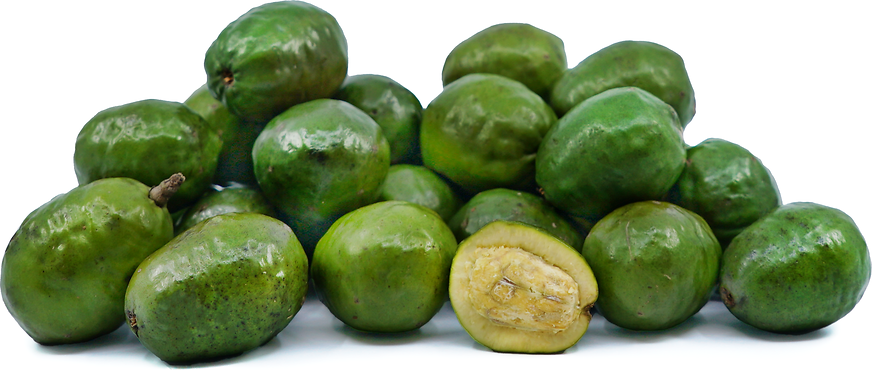


Green Spanish Plums
Estimated Inventory, lb : 0
Description/Taste
Green Spanish plums are small fruits, averaging 2 to 5 centimeters in diameter, and have an elongated, round to oval shape. The skin is semi-smooth, taut, thin, and shiny, ripening from green to yellow or bright red. Underneath the surface, the pulp is firm, yellow, acidic, and sour when young with a semi-dry, chalky consistency. With maturity, the flesh will soften, developing a sweet and juicy texture. There is also a large white seed tightly adhered to the flesh that is inedible, bitter, and fibrous. Green Spanish plums are the unripe versions of the fruits, bearing a crunchy texture, and have an astringent, musky, and tangy flavor with green apple notes.
Seasons/Availability
Green Spanish plums are generally available in the summer through fall. In some tropical regions, multiple seasons of fruiting may occur year-round.
Current Facts
Green Spanish plums, botanically classified as Spondias purpurea, are unripe, small fruits found on deciduous trees belonging to the Anacardiaceae or cashew family. The tropical, somewhat rare fruits are native to Central and South America and are not commercially cultivated on a large scale, primarily found growing wild or planted in home gardens. Green Spanish plums were introduced worldwide in the 16th century and are known by many names, including Ciruela, Jocote, Makok, Hog’s Plum, Siniguelas, and Mombin. There are many different varieties generally labeled as Spanish plums in fresh markets, and the fruits begin green, maturing to hues of yellow and red. The name Green Spanish plum is a descriptor used for unripe fruits that have been harvested before maturity. The green fruits are favored for their tart and sour nature and are used as a flavoring for beverages and culinary dishes.
Nutritional Value
Green Spanish plums are an excellent source of vitamins A and C, antioxidants that reduce inflammation, strengthen the immune system, and boost collagen production within the skin. The fruits are also a good source of fiber to regulate the digestive tract and provide some B vitamins, calcium, iron, and phosphorus. In Central America, the fruits are used as natural medicine, consumed as a diuretic, or boiled in water and applied to sores and wounds.
Applications
Green Spanish plums are astringent and are best consumed with additional ingredients to balance the tart flavor. In Mexico, the green fruits are coated in a mixture of salt, vinegar, lime juice, or chile powder and are eaten as a snack. The fruits can also be coated in sugar for a sweeter flavor. In addition to eating raw, Green Spanish plums can be used to make a tart green sauce for roasted meats, juiced and mixed with sweeteners as a refreshing beverage, stewed whole with sugar, or pickled for extended use. Green Spanish plums pair well with brown sugar, cinnamon, chile peppers, salt, vinegar, tomatoes, spinach, meats such as pork, chicken, and fish, garlic, onions, and cilantro. Whole, unwashed Green Spanish plums will keep 3 to 5 days when stored in a plastic bag in the crisper drawer of the refrigerator.
Ethnic/Cultural Info
Outside of its native region, Green Spanish plums are common in the Philippines and are a favored souring agent in local dishes. The fruits were introduced to the Philippines through Spanish explorers, locally known as Siniguelas, and the trees were initially used as property barriers. Spanish plum trees have since naturalized across the island nation, growing in forests and pastures, and in the modern-day, the trees are also a natural part of Filipino home gardens. The trees are low maintenance, adapting well to the tropical, humid climate, and drop their leaves before the fruits mature, creating an unusual visual with green fruits on bare branches. In addition to the trees, Green Spanish plums are a popular tart flavoring, sprinkled with salt and vinegar, and consumed as a snack. They are also frequently incorporated into sinigang, a sour soup with cooked meats, and kinilaw, a raw dish that consists of seafood, vegetables, and fresh-squeezed, tangy fruit juices.
Geography/History
Green Spanish plums are native to tropical regions spanning from Southern Mexico to Northern Brazil. The small fruits have been growing wild since ancient times and were spread to the Philippines, Caribbean, and Africa through Spanish explorers in the 16th century. Green Spanish plums were also introduced from Colombia into the United States in 1914 and then again from Panama in 1921, but the fruits did not become widely cultivated, reducing its population to areas of Southern Florida. Today Green Spanish plums are grown on a small scale through select farms and home gardens and are also foraged from wild trees when in season. The fruits are sold through local farmer’s markets and specialty grocers and are available in Central America, South America, Mexico, the United States, the Caribbean, Africa, Southeast Asia, and India.
Recipe Ideas
Recipes that include Green Spanish Plums. One
| Bacon is Magic |
|
Kinilaw |
| Family Friends Food |
|
Pickled Green Plums |
| Panlasang Pinoy |
|
Pork Sinigang |
| Dominican Cooking |
|
Dulce de Fruta en Almibar |
| CKBK |
|
Sour Plum Chutney With Chile Oil |








